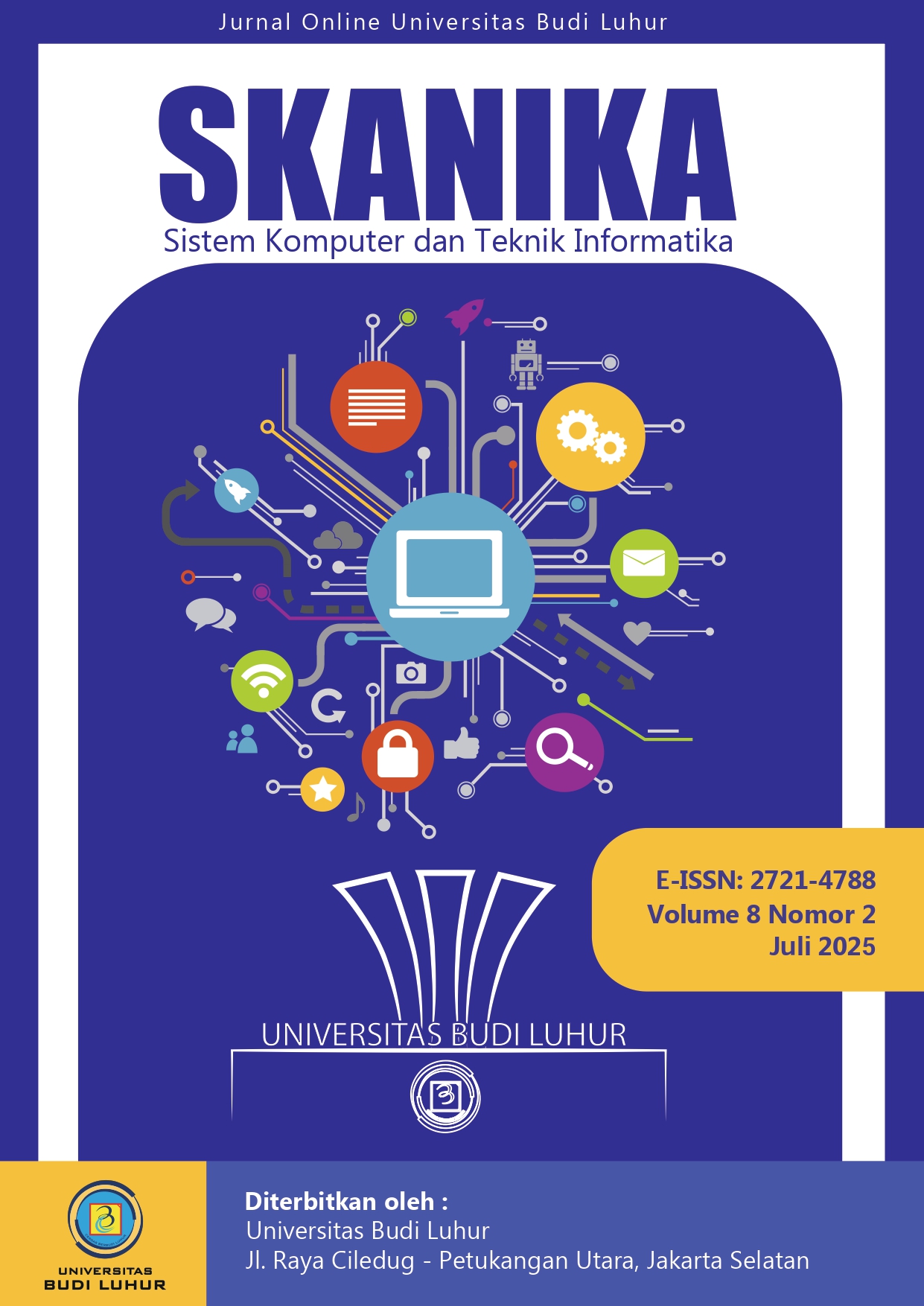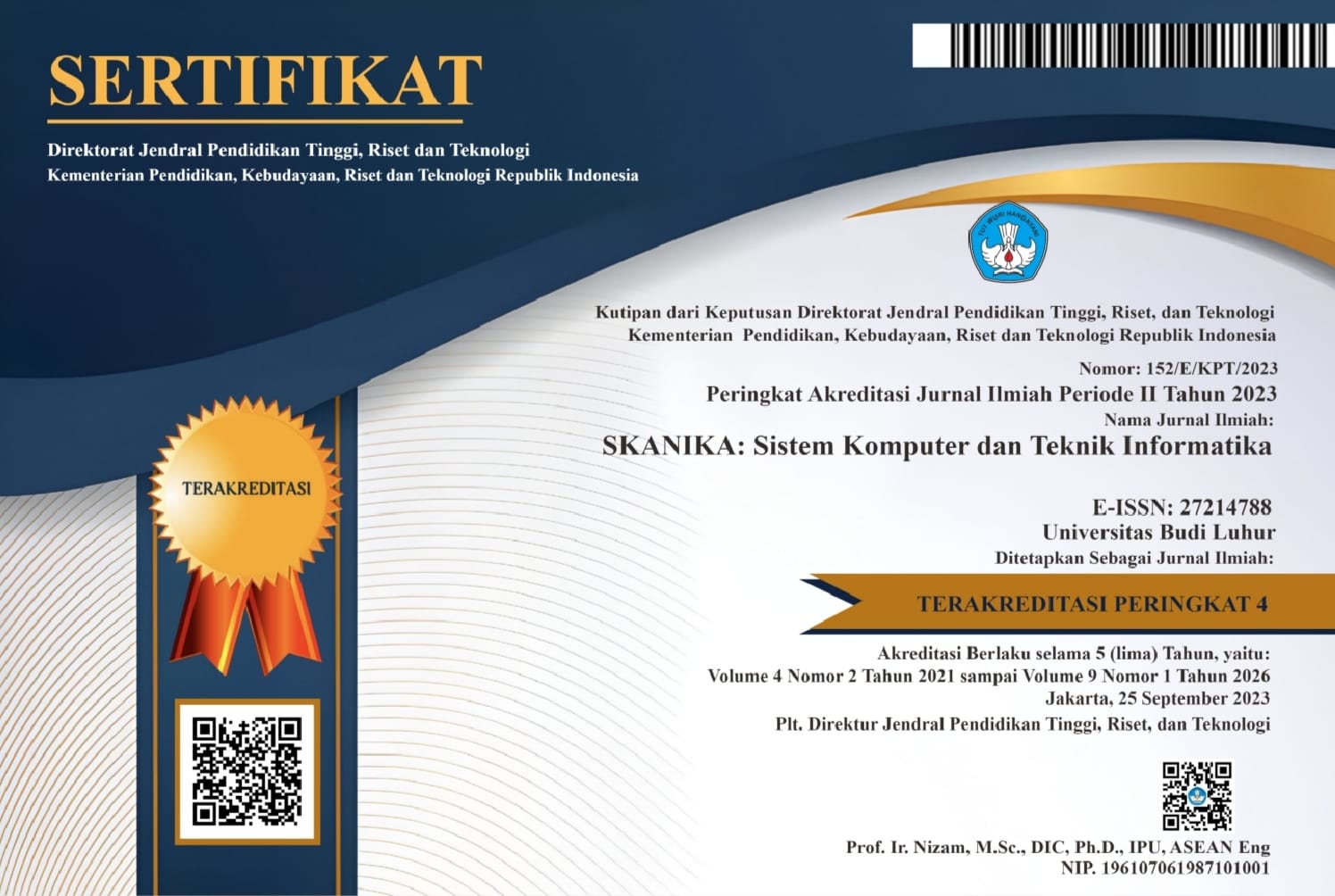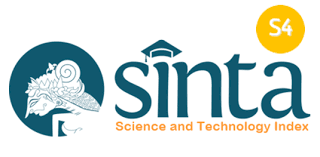PENGEMBANGAN SISTEM REKOMENDASI BERPAKAIAN MENGGUNAKAN LOCAL BINARY PATTERN DAN K-NEAREST NEIGHBOR DI PROGRAM STUDI TEKNIK INFORMATIKA UNIVERSITAS PELITA BANGSA
DOI:
https://doi.org/10.36080/skanika.v8i2.3584Keywords:
student dress code, Local Binary Pattern (LBP), K-Nearest Neighbor (K-NN), formal clothing detection, image classificationAbstract
The student code of ethics governs behavior, speech, actions, appearance, and dress during their academic journey. At Pelita Bangsa University, many students tend to follow evolving fashion trends, which often conflict with the faculty's dress code that emphasizes wearing formal, collared clothing. This research addresses the issue by developing an image-based detection system to identify whether students wear formal or informal attire. The study utilizes the Local Binary Pattern (LBP) method for feature extraction and the K-Nearest Neighbor (K-NN) method for classification. A total of 130 images were tested, consisting of 70 t-shirts and 60 shirts. The best accuracy was achieved using parameters R=1 and P=8 for LBP and K=1 with Euclidean distance for K-NN, resulting in an average accuracy of 95.16%. The developed system is capable of accurately classifying images of t-shirts and shirts, demonstrating high precision and efficiency in image-based classification. These findings indicate that the application of the Local Binary Pattern (LBP) and K-Nearest Neighbor (K-NN) methods is an effective combination for detecting compliance with student dress code regulations
Downloads
References
[1] L. K. Durgam and R. K. Jatoth, “Real-Time Dress Code Detection using MobileNetV2 Transfer Learning on NVIDIA Jetson Nano,” ACM Int. Conf. Proceeding Ser., pp. 10–17, 2023, doi: 10.1145/3638985.3638987.
[2] B. A. Kumar and M. Bansal, “Face Mask Detection on Photo and Real-Time Video Images Using Caffe-MobileNetV2 Transfer Learning,” Appl. Sci., vol. 13, no. 2, 2023, doi: 10.3390/app13020935.
[3] Y. Shah, et al., “Smart Wardrobe: A Comprehensive Approach to Personalized Clothing Recommendation with The Use of Nearest Neighbor Model,” pp. 6898–6907, 2024.
[4] D. D. Ariani, S. Zuhriyah, E. Y. Puspaningrum, and M. Pallawabonang, “Identification of Papua Cenderawasih Batik Motifs using Local Binary Pattern and K-Nearest Neighbor,” Sistemasi, vol. 14, no. 2, pp. 623-633, 2025, doi: 10.32520/stmsi.v14i2.5008.
[5] R. N. Putri, D. Kiswanto, and K. S. A. Sitepu, “Classification of Pear Varieties Using the K-Nearest Neighbor Algorithm and Extraction of Shape, Color, Texture, and Size Features,” Golden Ratio Data Summ., vol. 5, no. 1, pp. 01–07, 2025, doi: 10.52970/grdis.v5i1.910.
[6] K. Kevin, J. Hendryli, and D. E. Herwindiati, “Klasifikasi Kain Tenun Berdasarkan Tekstur & Warna Dengan Metode K-Nn,” Comput. J. Comput. Sci. Inf. Syst., vol. 3, no. 2, pp. 85-95, 2019, doi: 10.24912/computatio.v3i2.6028.
[7] P. P. Arhandi, M. Mentari, and F. Romadhon, “Kombinasi Metode Logical Binary Pattern dan K-Nearest Neighbor untuk Identifikasi Lubang pada Jalan Aspal,” J. Nas. Pendidik. Tek. Inform., vol. 10, no. 1, pp. 11-23, 2021, doi: 10.23887/janapati.v10i1.30999.
[8] N. S. Fatimah and S. Agustin, “Klasifikasi Citra Batik Menggunakan Local Binary Pattern (LBP) dan Support Vector Machine (SVM),” J. Algoritm., vol. 22, no. 1, pp. 185–196, 2025, doi: 10.33364/algoritma/v.22-1.2208.
[9] R. M. Rachman, M. M. N. S. Adi, and A. Ardiansyah, “Implementasi Local Binary Pattern Histogram Dalam Multiple Face Recognition,” Prosiding STAINS: Seminar Nasional & Sains, vol. 3, pp. 245–250, 2024, doi: https://doi.org/10.29407/stains.v3i1.4297.
[10] A. H. Rangkuti, A. Harjoko, and A. Putra, “A Novel Reliable Approach for Image Batik Classification That Invariant with Scale and Rotation Using MU2ECS-LBP Algorithm,” Procedia Comput. Sci., vol. 179, no. 2019, pp. 863–870, 2021, doi: 10.1016/j.procs.2021.01.075.
[11] C. Vararu, C. Simionescu, and A. Iftene, “Integrated Approach for Clothing Detection and Comparison using Structural Shape Detection and Texture Analysis,” Procedia Computer Scient, vol. 225, pp. 2546–2555, 2023, doi: 10.1016/j.procs.2023.10.246.
[12] J. Banjarnahor, et al., “K-Nearest Neighbor (Knn) Analysis for Clothing Sales Classification Based on Materials Used,” Jurnal Sistem Informasi dan Ilmu Komputer Prima (JUSIKOM PRIMA), vol. 7, no. 1, pp. 42–49, 2023, doi: 10.34012/jurnalsisteminformasidanilmukomputer.v7i1.3903.
[13] B. Sree Vidya and E. Chandra, “Entropy based Local Binary Pattern (ELBP) feature extraction technique of multimodal biometrics as defence mechanism for cloud storage,” Alexandria Eng. J., vol. 58, no. 1, pp. 103–114, 2019, doi: 10.1016/j.aej.2018.12.008.
[14] F. Regan, “Sensor Network Analyzer,” Connect, vol. D, 2022.
[15] A. Raka Atmaja, “Penerapan Local Binary Pattern (LBP) dan K-Nearest Neighbors (Knn) Untuk Mendeteksi Penyakit Buah Tomat,” J. Sci. Soc. Res., vol. 4307, no. 3, pp. 1028–1037, 2024, doi: https://doi.org/10.54314/jssr.v7i3.2104.
Downloads
Published
How to Cite
Issue
Section
License
Copyright (c) 2025 M. Najamuddin Dwi Miharja, Helmi Ahmad Fauzi Candra, Nanang Tedi

This work is licensed under a Creative Commons Attribution-ShareAlike 4.0 International License.
CC BY-SA 4.0
Creative Commons Attribution-ShareAlike 4.0 International
This license requires that reusers give credit to the creator. It allows reusers to distribute, remix, adapt, and build upon the material in any medium or format, even for commercial purposes. If others remix, adapt, or build upon the material, they must license the modified material under identical terms.
BY: Credit must be given to you, the creator.
SA: Adaptations must be shared under the same terms.ng












